


WELCOME
EL GATO CON BOTAS
50 YEARS OF MUSIC
SOUTHWEST GUITAR SYMPOSIUM EN VIVO
SONGS FOR A NEW WORLD
ALUMNI SPOTLIGHT: OLIVIA ZIMMERMAN
REENA ESMAIL IN THE HALL
CONTRIBUTORS:
Rolando Ramon - Chief Editor, Magazine Design, Photography
Suzanna Bridges-Keese - PR Assistant, Editor
Sebastian Forestier - Graphic Design
Milena Sousa - Photography, Social Media
CONTENTS 03 04 10 14 20 30 34 36
Page 02 |March 2024
Welcome to
Welcome to
CADENZA
Showcasing UTSA School of Music
Friends,
Welcome to the March issue of Cadenza, where we come roaring in with a host of concerts! We invite you to peruse the many features in this issue about the New Music Festival, the Southwest Guitar Symposium, and TWO Lyric Theatre productions! With this much to offer, we look forward to seeing you soon in our Recital Hall! And as always, we are grateful for your support of our guest, students and faculty performers.
This issue is packed with feature articles – including a history spanning the 50 years of Music at UTSA! Our Alumni Spotlight this month features Olivia Zimmermann and lots of concert announcements and articles will have you marking your calendar for upcoming events. In this anniversary year, we welcome your submissions, as well – we know our alumni are doing amazing work in a wide range of fields, and we’d love to hear from you!
Remember to check our online event calendar for the most up-todate concert information. And share Cadenza with your friends and family outside of San Antonio; they can check out the livestreams of our performances on our School of Music Facebook page! As always, we hope that all of you will take this opportunity to follow us on social media, where we post fun features on our students, faculty, and staff, link to our livestreams, and share photos and video clips of all that is taking place in the UTSA School of Music.
Are you interested in having live music at your own event? You could hire a student group! Look for the “Book Us” link on the School of Music website! And as always, we invite our alumni to submit your news and reconnect with your UTSA Music friends by sending an update to music@utsa.edu. We look forward to seeing you soon for live music at UTSA!
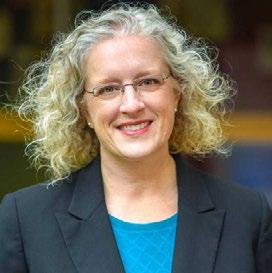 Dr. Tracy Cowden
Roland K. Blumberg Endowed Professor in Music Director of the UTSA School of Music
Dr. Tracy Cowden
Roland K. Blumberg Endowed Professor in Music Director of the UTSA School of Music

Page 03 | March 2024
BACHELOR OF ARTS IN COMMERCIAL AND DIGITAL MUSIC
COMING FALL 2024



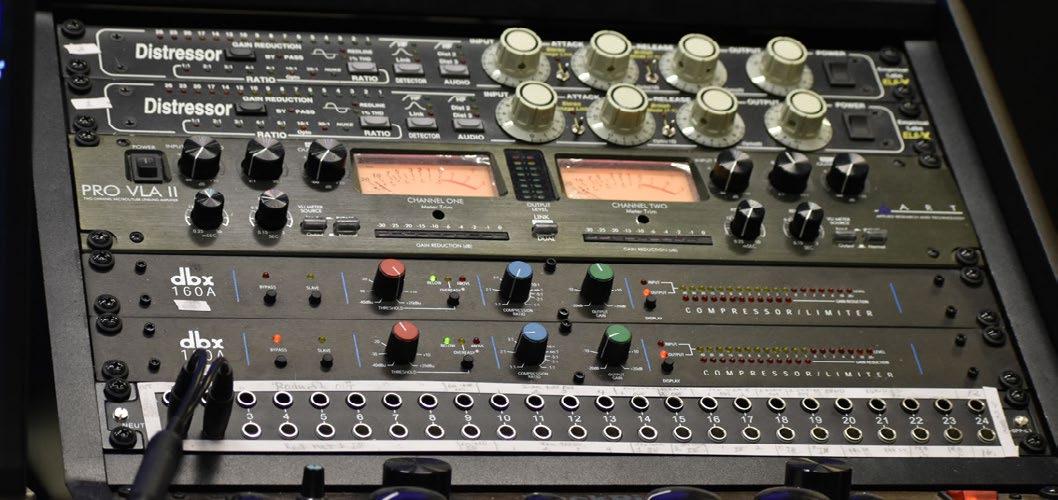
Are you interested in...
DIGITAL MEDIA
AUDIO ENGINEERING

SONGWRITING
FILM AND GAME MUSIC
POPULAR MUSIC STYLES
Apply for a flexible new program that welcomes students from diverse musical backgrounds who have varied interests in the evolving music industry.
Craft your curriculum by completing courses in three of four focus areas:
COMPOSITION AND PRODUCTION
MUSIC HISTORY AND CULTURE
MUSIC PERFORMANCE
MUSIC TECHNOLOGY
Use non-music electives to minor or double-major in related fields:
BUSINESS
MEXICAN-AMERICAN STUDIES
FILM STUDIES
LANGUAGE STUDIES
DANCE
COMPUTER SCIENCE AND MORE...
LEARN MORE AND APPLY AT MUSIC.UTSA.EDU

MONTESALVATGE’S EL GATO IN THE UTSA RECITAL HALL THIS MONTH
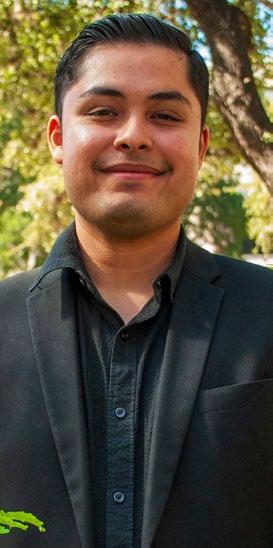






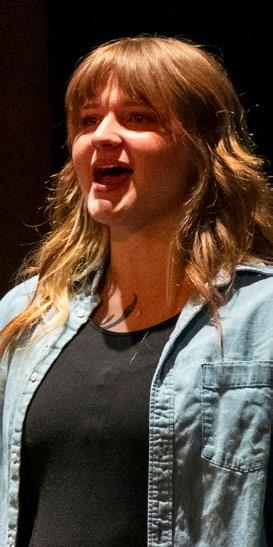

By 2024, Western culture is well-acquainted with the classic fairytale, “Puss in Boots.” Recent pop culture adaptations have made the story’s titular character incredibly popular among young audiences. With that in mind, 210 area residents can look forward to UTSA Lyric Theatre’s upcoming performances of El Gato Con Botas, an operatic adaptation of the savvy feline. Sung entirely in Spanish, El Gato makes its run March 21-24 in the UTSA Recital Hall (Main Campus).
An adaptation of the original story and character by Charles Perrault, El Gato Con Botas was composed by Spanish composer Xavier Montsalvatge in 1947 and premiered in Barcelona in the following year. The Lyric Theatre’s production is double cast and will be sung entirely in Spanish, a fact that many residents of San Antonio may find appealing.
The plot follows an ambitious, sword-wielding cat (Alyssa Moreno, Callan Sramek) who dons a hat and boots on a journey to acquire riches and spark the flames of love between its lowly Miller master (Osvaldo Chacon, Lucas Moncada Zoll) and the Princess (Francheska Lugo, Emily Densmore). The mischievous cat must use his wits and ingenuity to outsmart an Ogre (Abraham Gomez), take his castle, and impress the King (Antonio Zubillaga, Joshua Moncada Zoll).
Running at an hour in length (approx.), El Gato Con Botas is the perfect choice for a family outing or class trip to the opera. With a whimsical set and many humorous moments throughout, attendees of all ages will enjoy the show as presented by UTSA Lyric Theatre and its talented voice students. The Thursday, Friday, and Saturday shows begin at 7:30 p.m. and Sunday’s matinee starts at 3:00 p.m. Audiences can purchase tickets at https://colfa.utsa.edu/tickets .
Jourdan Laine Howell (Associate Professor of Instruction, Voice & Lyric Theatre) is directing the show alongside student director Justin Chappell with the musical score impeccably played by pianist Anna Hakobyan. The third production of UTSA Lyric Theatre’s 2023-2024 season, El Gato Con Botas is followed by Songs for a New World directed by Bill McCrary, April 4-7 at the new Wonder Theatre (Wonderland of America Mall). The season closes with The VERDI Project, a grand and new fully orchestrated show conducted by Maestro Troy Peters at Edgewood Performing Arts Center, one night only, Friday, April 26 at 7:00 p.m.
Learn more about the UTSA Lyric Theatre at https://utsalyrictheatre.org
*Pictured above: Osvaldo Chacon, Lucas Moncada Zoll, Emily Densmore, Francheska Lugo, Joshua Moncada Zoll, Antonio Zubillaga, Alyssa Moreno, Callan Sramek, Abraham Gomez
Page 06 | March 2024

Page 07| March 2024

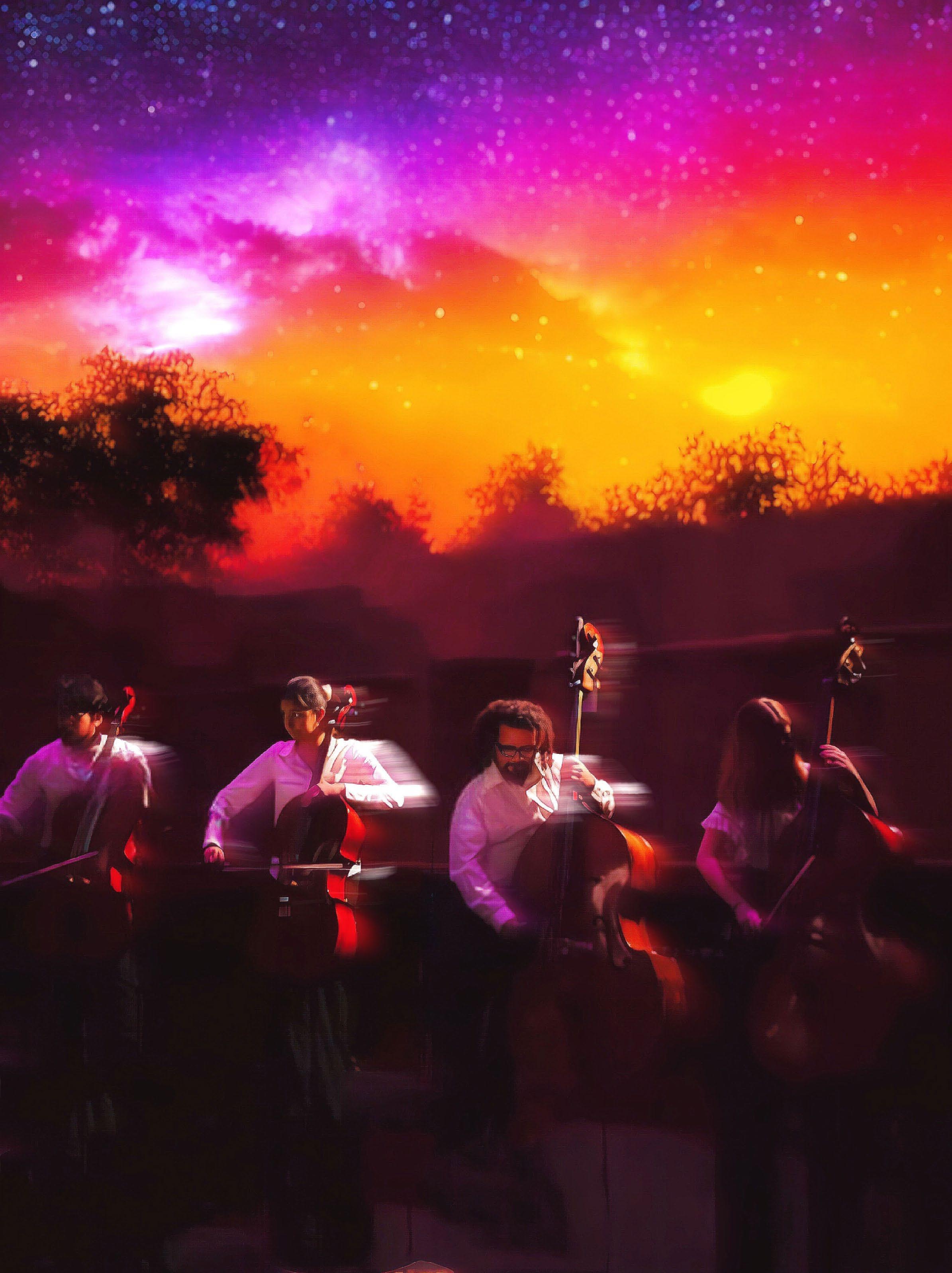



Page 10 | March 2024

Page 11 | March 2024
NEW MUSIC FESTIVAL’S RESIDENT COMPOSER
Written by Suzanna Keese-Bridges

UTSA New Music Festival 2024’s Distinguished Guest Composer is Dr. Reena Esmail. She holds degrees in composition from The Juilliard School (BM’05) and the Yale School of Music (MM’11, MMA’14, DMA’18). Her primary instructors have included Susan Botti, Aaron Jay Kernis, Christopher Theofanidis, Christopher Rouse, and Samuel Adler. Esmail also received a Fulbright-Nehru grant to study Hindustani music in India.

Esmail’s work is featured on March 5 and March 7 during the festival week. As she anticipates the upcoming performances of her work, she discusses her introduction to composition and her innate understanding of the craft.
“You know, I was always kind of making up second parts to go along with things, you know, when I was playing piano or guitar, violin, and when I was a kid, I would always kind of try to invent my own things,” Esmail reflects. “It really wasn’t until I was 16 years old, when I went to an arts high school and the theory faculty there introduced me to composition, but I think in some ways composing chose me more than I chose it.”
Her pieces being performed at New Music Festival are titled Interglow, Juleh Juleh, Sauce, and Blaze. Esmail reflects on the influences that factored into their composition.
“All of these are inspired by Indian classical and Western classical music and put into
Page 12 | March 2024
chamber ensembles,” Esmail states. “My main instrument is piano, so whenever I’m composing, I usually always begin at the piano.”
Esmail’s longtime love for piano can be heard throughout the few pieces presented at NuMu.
“Sauce and Juleh Juleh both have piano in them,” Esmail states. “With this, the writing is sort of similar and relative to the color and texture of French sounds, especially impressionistic piano music found in France.”
Esmail notes that the beginning stages of composition vary among composers and artists; in other words, there is no one correct way to do it.
“Creativity is so hard to pin down,” Esmail reflects. “I wish we could say, ‘Oh, this is how we compose a piece,’ but I think composers are always scanning the world, eyeing what might be inspiring or ignite a spark, wherever you can.”
For many composers, it can be overwhelming to stick with just one concept or to create something that perfectly fits an idea. Esmail relates to this as an inner struggle all professional composers face at some point iand how it can be overcome.
“With composing, you have to really trust yourself and trust your ideas,” Esmail states. “What you don’t want to do is choose the first thing you come up with and say, ‘Okay, I just have to make this work’ because you need to put yourself in a headspace to not judge your own ideas and see all of their potential.”
As she prepares pieces for many different performers in her career, she understands the importance of their perception of the composition. She likes to see it reflected in their performance.
“I love the most when a performer feels that they can convey what is important to them through my music, because I learned so much about performers when I understand what matters to them and see how they use my music to convey what’s inside of their soul,” Esmail enthuses.


Page 13 | March 2024
Esmail’s work can be heard on March 5 and March 7 at the UTSA Recital Hall


Page 14 | March 2024


Page 15 | March 2024
50 BOLD YEARS OF CULTIVATING ARTISTS
This year, the UTSA School of Music celebrates its 50th anniversary. From its founding as a start-up music program to its current state as a fast-growing school of music and cultural arts center for San Antonio, the program has trained several generations of artists, educators, entrepeneurs, and music industry leaders.

PRELUDIO | 1969
Written
by
Rolando Ramon
With contributions by:
Dr. Robert Rustowicz
Dr. David Sebald
Dr. Eugene Dowdy
Dr. John Silantien
The University of Texas at San Antonio, now in its 54th year of existence, was founded in 1969. The bill that made it possible was signed into the Texas Legislature on the back of Frank Lombardino, affectionately known in history as the “Father of UTSA,” in front of the Alamo on June 5, 1969
Architect O’Neil Ford, known for his iconic design of the city’s Tower of Americas, penned the blueprints for its construction on 600 acres of land. UTSA’s first semester took place in the fall of 1973 with a class of 671 graduate students. In 1975, the university launched into full swing with the opening of undergraduate programs.

EARLY BEGINNINGS | 1974
In 1974, Dr. Gordon Lamb was chosen to lead the UTSA Division of Music. Lamb’s extensive background as a chorale director made him a suitable candidate, so for the division’s first two years, Lamb taught courses in graduate chamber chorale and conducting.
University executives originally envisioned the division as a supplemental program with only a university choir and band. However, Lamb had his own vision for what UTSA Music could be. In 1976, he assembled a small faculty comprised of musicologist Michael Fink, composer James Riley, pianist James Sheppard, organist Bess E. Hieronymus, and soon-to-be band director Robert Rustowicz.
“[Gordon] was thoroughly about business. We had a faculty meeting every Monday, and there were only five of us. He would encourage us to attend meetings across campus to become more in touch with what was happening ‘globally’…and of course, we were a little more concerned with trying to survive in here,” recalled Professor Emeritus Robert Rustowicz.
Under Lamb’s leadership, the faculty created the division’s first Bachelor of Music Education degree during this era. He would continue to serve as Division director until 1979, when he became UTSA Vice President of Academic Affairs, though he continued to conduct the Chamber Chorale until 1987.
Page 14 | February 2024
UTSA is signed into Texas Legislature on the back of Frank Lombardino, 1969
March 2024
Gordon Lamb conducts the 1976-1977 UTSA Chamber Chorale



Bess Hieronymous created the UTSA School of Music’s organ program and was the first woman in UTSA history to be granted full professorship. In 1982, she supervised the installation of a Casavant pipe organ in the UTSA Recital Hall, where it remains a permanent fixture. The university later named the organ after her in 2004.
INTRUMENTAL MUSIC PROGRAMS | 1976
Gordon Lamb first interviewed Dr. Robert Rustowicz for the band director position while he was a graduate assistant at the University of Cincinnati. He flew to San Antonio for an interview in May 1976. As the story goes, at the end of Rustowicz’s interview process, Lamb gave him a hypothetical $50,000 budget and asked what would be needed to outfit a wind ensemble. Rustowicz utilized the entire budget, and when he returned to campus several months later, he found that Lamb had purchased every requested item. From there, Rustowicz founded the UTSA Wind Ensemble (now known as the UTSA Wind Symphony) and the fledgling division’s instrumental ensemble program. He also taught conducting courses, for which he created a book– Basic Conducting Technique – Patterns and Gestures.
“[UTSA] has always been a remarkable place in which to work. Faculty have been tight as a group concerned about the process of its direction every year. I stayed for 36 years, and I did that because I was always able to teach my kids and then learn from them.”

A
CRUCIAL DEVELOPMENTS | 1979
Clarence “Joe” Steussy was named Lamb’s successor in 1979 and led the Division of Music into the new decade. The division’s faculty grew significantly with the addition of notable names such as Donald A. Hodges, Linda Poetschke, John Silantien, Reed K. Holmes, Janice Kay Hodges, and former Dean of Fine Arts and Humanities, Rhoderick E. Key.
The 1980s was an era of crucial development for the Division of Music. The division received official NASM (National Association of Schools of Music) accreditation in September 1980. Its academic offerings greatly expanded as new degrees in performance, composition, conducting, and other areas emerged
the division between 1980 and 1981 that included new classrooms, practice
and
Recital Hall. Before the hall’s construction, all the division’s concerts and recitals
in the UT Health and Science Center Auditorium.
Page 15 | February 2024
new building was constructed for
rooms, offices, rehearsal spaces,
the UTSA
were held
Michael A. Fink (1975)
Bess E. Hieronymous (1976)
Robert Rustowicz conducts the UTSA Wind Symphony, February 2024
Page 17 | March
Joe Steussy (left) and Alan Craven working on the new UTSA Alma Mater, January 1982, Quarterly


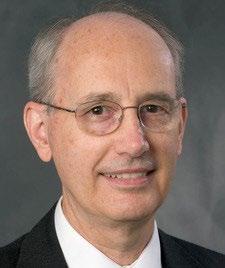

“When I joined the UTSA faculty in 1980, there were four buildings on campus and nothing but wooded land at the corner of De Zavala and IH10,” noted Silantien. “Upon my retirement thirty-eight years later, I looked back fondly at all the talented students and colleagues who worked to build a School of Music at a tier-one university.”

Fall 1982 saw the establishment of the UTSA Orchestra with Robert Rustowicz’s support. The ensemble initially began as a mixture of musicians from the local community and UTSA students. Janice Hodges soon took over as the ensemble’s conductor for several years. Donald Hodges succeeded her and conducted the ensemble into the early 1990s before San Antonio Symphony Resident Conductor David Mairs took over.
The division would undergo several changes in leadership at the director position during this period. Steussy stepped down as director in 1986 but continued to teach at UTSA. The division would then go through two interim directors. Don Hodges stepped in as acting director in 1986 for one year before Neil E. Wilson took over the following year. In 1988, Alexander Sidorowicz became the new permanent director for The Division of Music.
MUSIC TECHNOLOGY | 1989
During the 80s, there was a growing interest in technology among Division faculty. Computers had not yet been implemented in the classroom at UTSA. The Division of Music purchased a set of Apple lle personal computers in 1983, and faculty soon began to write educational programs on them. The Division of Music was the first to use computers for instruction at UTSA.
In 1989, Professor Emeritus David Sebald joined the faculty and established one of the country’s earliest music technology programs at UTSA. Sebald created numerous computer programs for music education and video game

Page 16 | February 2024
Linda Poetschke (1984)
Rhoderick E. Key (1981)
Donald A. Hodges (1980)
John Silantien with choral students
John Silantien (1980)
March 2024
Dave Sebald in his former office (now the Instrument Storage Room)



consoles on which students could play educational programs.
“I’d always wanted to come to San Antonio…I came to a TMEA Conference just for the fun of it, because I was teaching in Colorado at the time,” reflected Sebald. “It was February, and I saw flowers growing in the median of the highway, and I thought, ‘Oh god. How could this be?’ And I said, ‘This is the place for me.’”
As director of the Music Technology Program, he created the school’s Music Technology certificate program in 2004, which later became a minor.
A BLOOMING MUSIC PROGRAM | 1992
In 1992, Steussy began his second stint as division director. This decade saw the Division flourish as a music program with continued expansion. An innovative degree, Music Management (later renamed to Music Marketing) was created during this time. The program, led by David Bruenger, included courses in music industry, entrepreneurship, and music business.
Many familiar names that alumni as recent as the class of 2023 will recognize were appointed as well. The storied tenures of Emeritus faculty members that began during this era include orchestra director Eugene Dowdy, voice area faculty Gary Mabry and Diana Allan, flute professor Rita Linard, composition professor James Balentine, and guitar professor Matthew Dunne.
In 1991, Don Hodges, David Sebald, and Scott D. Lipscomb founded the UTSA Institute for Music Research. The institute was created to serve the purpose of advancing knowledge through the research of UTSA faculty in the areas of music psychology, pedagogy and learning, and technology. The institute created a bibliographic database for music research literature called CAIRSS for Music. The database provided researchers and practitioners universal access to thousands of articles and journals published worldwide on music research. It also hosted conferences and published multiple papers by the faculty.
With the backing of the IMR, Sebald created the Technological Directions in Music Learning (TDML) Conference at UTSA in 1992. During its ten-year run, the conference attracted music technology researchers from all over the United States to UTSA.
The early 1990s also saw the establishment of the Festival of New Music by Reed Holmes and James Balentine and the Southwest Guitar Festival by professor Gerald Klickstein and other Texas guitarists. The latter would eventually become the largest acoustic guitar festival in Texas under the direction of Matthew Dunne in 2000, which featured
Page 17 | February 2024
UTSA music technology lab, 1990s.
Dr. Eugene Dowdy conducts the UTSA Orchestra, late 1990s.
Page 19 | March 2024
UTSA Jazz Ensemble, early to late 1990s.
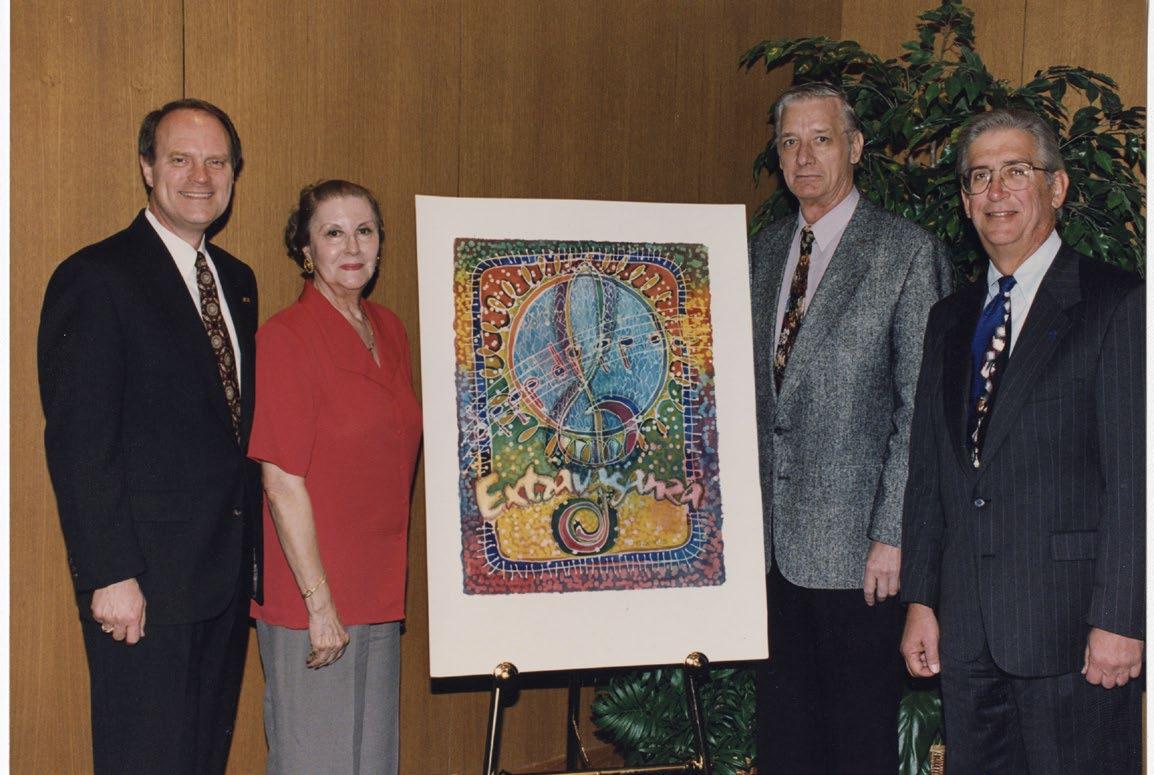


a 6-day slate of events that included concerts, masterclasses, and competitions across several venues in San Antonio.
In 1996, the Division of Music held its first Extravaganza, an annual awards ceremony recognizing student excellence. The original artwork for the event was designed by the late beloved San Antonio artist Brother Cletus Behlmann.
By 2000, UTSA had undergone a major academic restructuring that resulted in the formation of the College of Liberal and Fine Arts, followed by renaming the music program to the UTSA Department of Music.
When Joe Steussy departed from UTSA in 2002, Eugene Dowdy succeeded him as the new Department of Music Chair. Dowdy, a UTSA alum (M.M. ‘90) hired in 1996, had taken over the reins of the UTSA Orchestra and transformed the ensemble from a community orchestra into an all-student symphony by 2001.
Dowdy established the UTSA String Project in 2002 with a $30,000 grant award from FIPSE and served as its founding director. The program was created as a member of The National String Project Consortium (NSPC), of which Dowdy also spent 3 years as the executive director. The UTSA String Project allowed music education majors to gain early experience and skill development by giving beginning through advanced middle-school level instruction to community students on stringed instruments and classical guitar. For many UTSA string music education alumni, the String Project was one of their most significant experiences at UTSA.
“UTSA played a prominent role in my development as a music educator, conductor and music administrator. Being an alumnus of the UTSA Master of Music program myself [1990], I experienced the high quality of the music faculty and became a much stronger artist teacher,” Dowdy reflected. “Upon my appointment to the faculty, I was immediately drawn to both developing the orchestral program and providing departmental administration.”
Dowdy served as department chair until 2008 and once more as interim chair from 2018-2019.
“As a faculty member, department chair, and now professor emeritus, I know what makes the UTSA School of Music a tremendous program – it’s the music faculty – they are the heart of the school and they recruit, inspire and mentor our accomplished alumni base,” said Dowdy.
Extravaganza, 1996. Picture left to right: former UTSA President Samuel Kirkpatrick, Pamela Kirkpatrick, Brother Cletus Behlmann, Joe Steussy.
Eugene Dowdy (1996)
Page 20 | March 2024
UTSA All-State Choir Camp, 2002

Dowdy was succeeded as department chair by David Frego in the Fall of 2008. Frego, hired from Ohio State University, was the first faculty member to hold the Roland K. Blumberg Endowed Professorship in Music. UTSA Today described Frego in 2009 as “a nationally recognized scholar who joins the faculty and elevates the quality of research, creative activity, and teaching for UTSA music students.”
Under Frego, Ron Ellis was hired in 2010 to lead a new 150-member marching band, now known as the Spirit of San Antonio (SOSA), to be fielded in 2011 along with a new Division-I football team for UTSA. Both programs have grown tremendously since then.
Over the next decade, the Department of Music continued to reach new heights with the addition of world-class faculty and growth in academic offerings and resources, showing a strong commitment to music education. Faculty such as former UTSA music marketing pro fessor Stan Renard built a reputation of student employment success after graduation. Voice alumni found great success as professional opera vocalists and music education alumni established a nearly 100% employment rate post-graduation. Culture on campus bloomed into several student organizations where leadership and new ideas were cultivated among peers.

A NEW ERA | 2019
In 2019, Tracy Cowden succeeded David Frego as the next department chair of UTSA Music and was also granted the Roland K. Blumberg Endowed Professorship in Music. Under her leadership, the Department was finally reclassified as the UTSA School of Music in September 2022.
The UTSA String Project was named Most Outstanding NSPC String Project of the Year for 2023 during the National ASTA Conference in Florida. The annual award is given to a String Project that exemplifies the mission of the NSPC and influences new generations of highly qualified music educators while offering culturally diverse string instrument education opportunities for its students.
The UTSA School of Music strives for academic leadership and innovation in music education today as it continues to expand by introducing new degree and community outreach programs, prominent guest artist concerts, and a rising reputation for graduate success. The school’s most recently added degree program, a Bachelor of Arts in Commercial and Digital Music, may break public perceptions about barriers between fine arts institutions and non-classically trained musicians. This new program focuses on audio production, songwriting, and contemporary music styles.
Several events throughout the year have been labeled as commemorating the school’s 50th anniversary, with more planned for Fall 2024. These include past concerts by the UTSA Wind Symphony and Symphonic Band in February with Robert Rustowicz as a guest conductor and upcoming events such as the New Music Festival (March 3-7), Southwest Guitar Symposium (March 8-10), the UTSA Lyric Theatre’s The Verdi Project at the Edgewood Performing Arts Center (April 24), and Extravaganza XXVIII (date to be announced).
David Frego (2008)
Page 21 | March 2024
Tracy Cowden ushers in a new era as the UTSA School of Music, 2022.

Page 20 | March 2024

Page 23 | March 2024






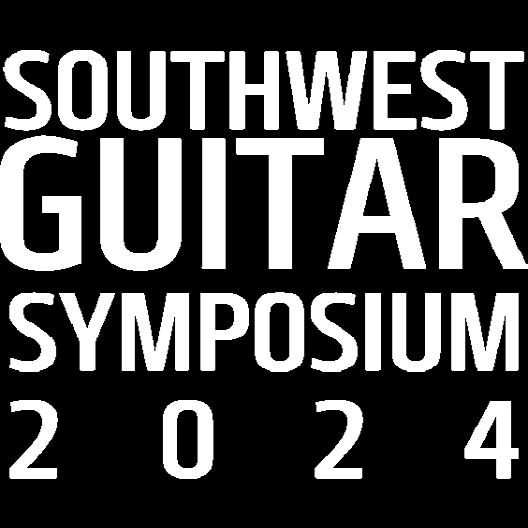






HIGH CALIBER PERFORMANCES AND ARTISTRY AT THE 2024 SOUTHWEST GUITAR SYMPOSIUM
The Southwest Guitar Symposium is known for bringing guitar virtuosos from around the world to give concerts and masterclasses at UTSA in the spring. This year’s line-up of guest artist appearances at the Symposium will also bear UTSA Arts’ En Vivo Guest Artist Series brand for the first time. Serving as the major highlight of 2024’s iteration of SWGS, the series will bring universally acclaimed guitarists William Kanengiser and Pablo Garibay to share the stage during its weekend run.
The two guitarists double-headline the UTSA Recital Hall on March 9, 2024, at 7:30 p.m. The evening concert follows the afternoon’s earlier concert at 5:00 p.m., which features 2023 Southwest Solo Guitar Competition Winners Adrian Montero and Wyatt Green. Though a performance of this caliber would usually come with a considerable price for admission at a typical venue or event, all concerts at the Southwest Guitar Symposium will be free to attend.
American artist William Kanengiser has been a guest artist at UTSA on multiple occasions. He performed at the Southwest Guitar Festival, the original incarnation of the Symposium, in 2003 and 2009 with the Los Angeles Guitar Quartet, of whom he is a founding member. Kanengiser has several accolades as an accomplished and well-respected virtuoso. Most notably, he’s received numerous Grammy award nominations, of which he’s won two. In 2004, he won a Grammy with the Los Angeles Guitar Quartet for Best Classical Crossover Album with Guitar Heroes (2004). Then he contributed to another Grammy award for Best Opera Performance for the Atlanta Symphony Orchestra’s 2007 performance of Osvaldo Golijov’s Ainadamar: Fountain Of Tears.
Pablo Garibay is one of Mexico’s most highly respected and widely praised musical talents. The guitar virtuoso has drawn international recognition from audiences and critics for his peculiar sensitivity to musicality and his work with the standard classical guitar repertoire and contemporary artists.
Kanengiser’s performance will have mostly contemporary works–most notably, he’ll be showcasing a piece composed by former UTSA guitar professor and Southwest Guitar Festival director Matthew Dunne. This piece, “The Village,” is the first movement of a larger work titled Beyond the Horizon.
The American virtuoso will also be performing Sevillana (Fantasia), Op. 29 by Joaquín Turina, English Suite by John Duarte, Three African Sketches by Dušan Bogdanović, and “Brookland Boogie” from Sketches for Friends by Brian Head.
Garibay’s performance will be his UTSA debut. It features Spanish composer Antonio Jose’s “Sonata para guitarra.” The latter is well-known in the classical guitar repertoire for its demanding complexity and beauty. It is Jose’s most famous work and one of only two pieces the composer wrote for guitar. Garibay will also perform Sonatina Meridional by Mexican composer Manuel Ponce.
Both guitarists will also be teaching masterclasses, where they’ll critique performances by multiple students in an open, two-hour class. William Kanengiser will teach his class at 1:00 p.m. on Saturday, March 9, and Garibay at 1:30 p.m. on the following day – symposium visitors can attend both sessions in the UTSA Arts Building, room AR 2.03.18A.

Page 26 | March 2024

William Kanengiser United States of America
William Kanengiser has forged a career that expands the possibilities of the classical guitar. A prize-winner in major competitions (1987 Concert Artists Guild International Competition, Toronto Guitar ’81) he has toured throughout North America, Asia, and Eur ope with his innovative programs and expressive musicianship. He recorded four CD’s for the GSP label, playing music as diverse as Carib bean, Eastern European, and jazz. A member of the guitar faculty at the USC Thornton School of Music since 1983, he has given master classes around the world and produced two instructional videos.
Most recently, he performed the U.S. premiere of “Folk Concerto” by Clarice Assad, with fellow LAGQ member Scott Tennant, and the Albany Symphony conducted by David Allan Miller.
An active proponent of new music, he recently received a grant from the Augustine Foundation for his “Diaspora Project,” commissioning seven new works focusing on issues of migration and assimilation. It includes new pieces by Sergio Assad, Dusan Bogdanovic, Golfam Khayam, and others. An advocate for musicians, wellness, he serves as Chair of the Thornton Musician’s Wellness Committee, curating their Wellness Initiative with health screenings and a lecture series, as well as creating a Musician’s Wellness course.
A prolific arranger, he has created dozens of transcriptions for solo guitar and guitar quartet, and composed a number of works for four guitars. In 2009 he created the stage production “The Illustrious Gentleman Don Quixote” for narrator and guitar quartet, writing the stage script and adapting music from the Spanish Renaissance. It was premiered with Monty Python member John Cleese, and extensively toured with Firesign Theater founder Phil Proctor.
As a founding member of the Los Angeles Guitar Quartet, William Kanengiser has given hundreds of recitals and concerto appearances around the world, and has recorded over a dozen releases. Their Telarc release “LAGQ Latin” was nominated for a GRAMMY®, and it was their Telarc title “LAGQ’S Guitar Heroes” which won a GRAMMY® in 2005 as the best classical crossover recording. Most recently, their recording of the title work on Pat Metheny’s “Road to the Sun” hit #1 on the Apple Music Classical chart.

Page 27 |March 2024
Pablo Garibay
Mexico
“A guitarist of rare sensitivity, nuance and musicality.”
- Joann Falletta
Hailed as ‘phenomenal’ by the General-Anzeiger newspaper in Bonn, Germany, Mexican guitarist Pab lo Garibay has established himself as a leading force on the international classical guitar scene, with his pioneering interpretations of well-known classics and impressive performances of lesser-known masterpieces.

An eminent performer of the great guitar concertos, Pablo Garibay is particularly known for his interpretations of Latin American music. As a concerto soloist, Pablo Garibay made his professional debut with the Orquesta Filarmónica de la Ciudad de Mexico. Recent performances have included appearances with the OFUNAM, Virginia Symphony Orchestra, New Britain Symphony, Salzburg Chamber Soloists, Orquesta Sinaloa de las Artes, Orquesta Filarmónica de Acapulco, Orquesta Cuidad de Almeria, Orchestre Royal de Chambre de Wallonie, Niedersächsisches Sinfonieorchester, and South African Chamber Orchestra. In addition, Pablo Garibay has appeared at major international festivals throughout Russia, France, Germany, Great Britain, Italy, Lithuania, Poland, Romania, South Africa, Costa Rica, Mexico and the United States.
A winner of no fewer than 16 international prizes, including 1st prize at the prestigious In ternational Francisco Tárrega Competition, Manuel Ponce International Guitar Competition, René Bartoli Competition, JoAnn Falletta International Guitar Concerto Competition, and In ternational Guitar Competition Aachen. Pablo Garibay studied with Juan Carlos Laguna and Iván Rísquez at the Universidad Nacional Autonóma de México, Thomas Müller-Pering at the Hochschule für Musik Franz Liszt Weimar, and Paolo Pegoraro and Giampaolo Bandini at the Festival Internazionale Parma.
Described as ‘exceptional in every regard’ by Norbert Kraft, A&R Executive – Naxos records, Pablo Garibay is no stranger to the recording studio, having recently released recordings of music by Scarlatti, Ravel, and Ponce with the NAXOS, Urtext, and Fleur de son classics labels. He is currently beholder of the FONCA scholarship to make premieres of pieces by Mexican composer Hebert Vázquez. He is represented by Aranjuez Artistic Services for piano and electronics.

Page 28 | March 2024

SWGS Winners Promo
Cuarteto de Guitarras de la Ciudad de México
Cuarteto de Guitarras de la Ciudad de México was formed in 2001 with the very purpose of performing contemporary Mexican music originally written for four guitars. Throughout its career, the quartet has performed in concert all over Mexico as well as in different countries in Europe and Latin America, within some of the most important festivals, which have included the world premiere of music dedicated to the quartet.

Apart from this, the quartet has made various broadcastings for several Mexican cultural radio and television channels. In 2011, as part of the celebration for its tenth anniversary, the quartet made the premiere in Mexico of Interchange, the concerto for guitar quartet and orchestra composed by Brazilian composer Sergio Assad.
Cuarteto de Guitarras de la Ciudad de México has published three recordings that have in common that each one of the pieces or arrangements they contain were commissioned by the ensemble to form interesting programs that contribute to the repertoire of this chamber formation. Jícamo a 4 (Urtext Digital Classics, 2005) has original music composed by five renowned composer-guitarists (Ernesto García de León, Juan Helguera, Julio César Oliva, Jorge Ritter and Gerardo Tamez). On the same page, ...a cinco (Clave Producciones, 2013) includes five chamber pieces for guitar quartet and a guest instrument (flute, voice, percussion, clarinet and live electronics) composed by Samuel Zyman, Jorge Sosa, Marcela Rodríguez, Jorge Ritter and Sabina Covarrubias. On the other hand, Sones y Danzones de Buena Madera (Tempus Clásico, 2014) is a showcase for Mexican music of traditional origin with brilliant arrangements for guitar quartet of popular sones jarochos, sones istmeños, and danzones, as well as symphonic music written by some of the most renowned Nationalist composers (such as José Pablo Moncayo, Blas Galindo and Arturo Márquez) which were also performed with twelve guitars made with Mexican endemic woods built by Abel García López, one of the most recognized luthiers in Mexico and worldwide. In 2024, the quartet celebrates the tenth anniversary of its release with a concert series which includes a tour in several festivals and universities in Texas.
Page 29 |March 2024


APRIL’S UTSA LYRIC THEATRE PRODUCTION SHOWCASES THE NEW WONDER THEATER


Shots from McCrary’s productions last year.
Top: Chloe and the Magical Christmas Forest.
Bottom: A Little Night Music
Under the direction of Bill McCrary, the UTSA Lyric Theatre will perform Jason Robert Brown’s Songs for a New World at the Wonder Theatre on April 4-6 at 7:30 p.m. and a Sunday matinee on April 7 at 3 p.m.
The power-ballad infused production was originally put on stage by the WPA Theatre in 1995 in New York City by Kyle Renick, artistic director. The performance will review themes of self-discovery, history, and optimism with contemporary scores that audiences will adore and relate to.
Dr. McCrary joined UTSA 2001 and was responsible for introducing musicals and renaming its opera program to the UTSA Lyric Theatre. He’s excited to bring this production to the UTSA and San Antonio community at the Wonder Theatre, a new space located within the Wonderland of the Americas Mall. The facility is a nonprofit, live performance theater with the goal of engaging the San Antonio community through musical productions all year long. The ensemble of voices features Bernadette Fernandez, Alexandra Sanchez, Nicholas Garza, Dylan Ramirez, and Michael Reyes, all UTSA music major students. UTSA Dance, choreographed by Michelle Pietri for this production, will join them on stage.
“We are excited to have the Musical Theatre dance class join us on stage for this production when we perform at the Wonder Theatre,” McCrary comments.
The orchestra for the Lyric Theatre’s production of Songs for a New World will be directed by Dr. Jordan Boyd and accompanied by Billie Whitaker as the rehearsal pianist. Boyd is also the Assistant Director of Choral Activities for the University of Texas at San Antonio and has ‘conducted ensembles at virtually every level.’
“While the narrative structure of Songs For a New World may seem quite disjointed, the music flows from number to number quite seamlessly,” Boyd reflects. “It’s a tour de force of different styles that allow the singers to showcase their incredible talents and proves the genius of Jason Robert Brown’s writing, and I believe there’s something for everyone in this show!”
- Suzanna Bridges-Keese
Page 32 | March 2024

Page 33 | March 2024
MARCH 2024 ALUMNI SPOTLIGHT

OLIVIA ZIMMERMAN
PH.D. PIANO PERFORMANCE CLASS OF 2007
March’s alumni spotlight shines on Dr. Olivia Zimmermann, who graduated from UTSA with a bachelor’s in piano performance in 2007 and went on to receive a Master’s at Northwestern University, Chicago, and Ph.D at the University of Kansas. Currently, Zimmermann teaches students lessons at her private studio in Liberty, Missouri.
While an undergraduate at UTSA, and even in high school, the piano prowess knew she had a future of helping students learn to play; however, at first she wanted to be a professor, and was inspired by an instructor of hers.
“When I met Kathy in high school, it was so amazing to experience how she played, her artistry, and the person she was,” Zimmermann states. “She was there for me when my mom passed from cancer, and became a model woman figure in my life; I just wanted to be like
get it done.”
After her time at University of Kansas, and meeting with her personal pedagogy professor, Scott McBride Smith, she decided to not go into higher education due to low pay and was encouraged that having a private studio would be just as successful.
“ I’m my own boss, I have my own standards and hours, and a much better working space,” Zimmermann states. “I thoroughly enjoy it.”
During her time at the University of Kansas, Zimmermann received a Fulbright grant to study at the Sibelius Academy in Helsinki, Finland. Many opportunities arose for Zimmermann to partake in that she learned and grew from as a future music educator.
“There were so many opportunities with Fulbright to bring Finnish and American music to such a wide audience,” Zimmermann states. “Because this was the first time since HS where I didn’t have a full time job or full time school, I decided to teach during my free time.”
The Sibelius Academy, alongside being the only music academy in Finland, is one of the largest in the world and was re-named from its previous title “” to honor former student and celebrated composer, Jean Sibelius. As a former student who studied under Erik T. Tawaststjerna, son of Erik W. Tawaststjerna and a
Page 34 | March 2024
NOW AND FOREVER I AM A ROADRUNNER
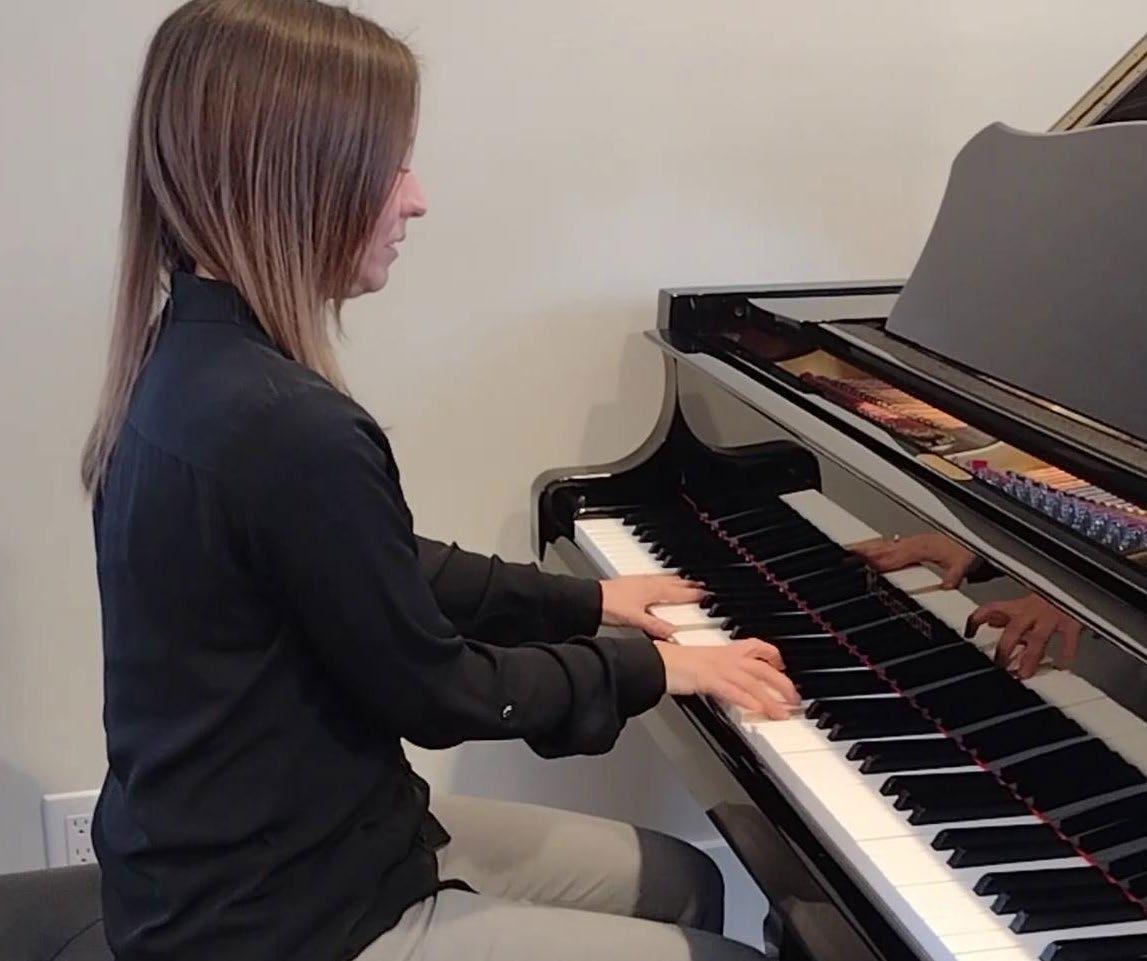
close friend to Sibelius, she often reflects on the invaluable lessons and opportunities she had partaken in.
“It was incredible to know I had direct line to the best interpretive knowledge of his [Sibelius] piano music,” Zimmermann states. “Erik recorded a lot of his works and helped me even before I went to Finland in person.”
As an instructor, Zimmerman feels one of the most rewarding aspects is seeing how her students grow and learn overtime. She notes that she feels lucky to do what she does.
“What I love most is I get to pass it on; teachers pass on wisdom and it creates so much joy and beauty,” Zimmermann reflects. “When I see the look on their faces when they discover something new and fantastic, to watch them take flight and become their own pianist and musician, and experience joy like I did, that is the most rewarding.”
When she instructs, she starts by asking her new or beginner students why they want to play, and uses this to understand how to approach their learning style.
“I also ask them what they like or want to play, maybe a bucket list piece they would love to try,” Zimmermann reflects. “I also tell them how I teach, and build a foundation with them, requiring their parents to sit and listen to this conversation as well.”
Some of Zimmerman’s favorite pieces to play are from the Baroque period, and some composers include the well-known Mozart and Bach. Another favorite of hers is Alexander Scriabian, who was a late-19th century Russian composer.
“ His late period is very abstract and makes you feel otherworldly,” Zimmermann states. “His pieces are euphoric to play and listen to.”
During her time at UTSA, Dr. Kasandra Keeling was one of her mentors that inspires her to this day through her knowledge and fantastic teaching. Currently, Dr. Keeling is Professor of Music, Acting Associate Director of the School of Music, and Keyboard Area Coordinator at UTSA.
“She and my high school piano teacher were best friends, and she’s how I was introduced to UTSA,” Zimmerman notes. “For Dr. Keeling, it wasn’t just teaching technique or developing sight reading– she taught the whole person, not just pianist, and I’m thankful that she was so considerate and thoughtful while teaching me.”
- Suzanna Bridges-Keese
Page 35 | March 2024


GUEST ARTIST SERIES
2023-2024 SEASON
BRINGING WORLD-CLASS ARTISTS TO SAN ANTONIO



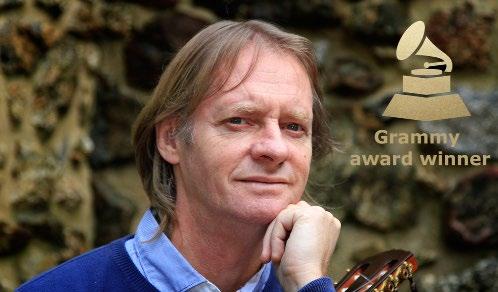
ANTHONY PLOG, trumpet
March 21 – Masterclass

ALAN WOO, piano
March 25 – Convocation Performance
AGARITA, piano quartet
April 13 – Performance
DAVID RUSSELL, guitar
April 20 – Performance
Grammy Award-winning artist
Page 37 |March 2024
STUDENT
Christian Tapia
NEW MUSIC FESTIVAL
Vocal Art Series
3:00 PM | Radius Center
NEW MUSIC FESTIVAL
Oswaldo Zapata & Kasandra Keeling
3:00 PM | UTSA Recital Hall
NEW MUSIC FESTIVAL
UTSA Chamber Ensembles
7:30 PM | UTSA Recital Hall
NEW MUSIC FESTIVAL
UTSA Wind Symphony & Symphonic Band
7:30 PM | UTSA Recital Hall
NEW MUSIC FESTIVAL
UTSA Choirs
7:30 PM | UTSA Recital Hall
Duo Fortis and Tracy Cowden
7:30 PM
Southwest Solo Guitar Competition Winners Concert
5:00 PM | UTSA Recital Hall
SOUTHWEST GUITAR SYMPOSIUM
Pablo Garibay and William Kanengiser
7:30 PM | UTSA Recital Hall
SOUTHWEST GUITAR SYMPOSIUM
Cuarteto de Guitarras de la Ciudad de
7:30 PM |
UTSA
3:00
STUDENT
Sophie Andersen
7:30 PM |
LOW
Page 38 | March 2024
7:30 PM |
STUDENT RECITAL
Marco Corrales
5:00 PM | UTSA Recital Hall
STUDENT RECITAL
Jesse Reece
7:30 PM | UTSA Recital Hall
STUDENT RECITAL
Cerros & Andersen
5:00 PM | UTSA Recital Hall
STUDENT RECITAL
Kenedy & Lerma
7:30 PM | UTSA Recital Hall
STUDENT RECITAL
Sam Bowman
5:00 PM | UTSA Recital Hall
STUDENT RECITAL
Brandon Ichavez
GUITAR SYMPOSIUM
SOUTHWEST
|
SOUTHWEST GUITAR SYMPOSIUM
UTSA Recital Hall
México
UTSA Recital Hall EL GATO CON BOTAS UTSA Lyric Theatre 7:30 PM | UTSA Recital Hall EL GATO CON BOTAS UTSA Lyric Theatre 7:30 PM | UTSA Recital Hall EL GATO CON BOTAS UTSA Lyric Theatre 7:30 PM | UTSA Recital Hall EL GATO CON BOTAS
Lyric Theatre
PM | UTSA Recital Hall
RECITAL
UTSA Recital Hall
BRASS STUDIO RECITAL
PM | UTSA Recital Hall
01 03 04 05 06 07 08 09 09 10 21 22 23 24 25 26 MARCH 2024 26 27 27 28 28 29 29 JAZZ COMBO
5:00
UPCOMING DATES
UTSA Recital Hall
7:30 PM | UTSA Recital Hall RECITAL
5:00 PN | UTSA Recital Hall
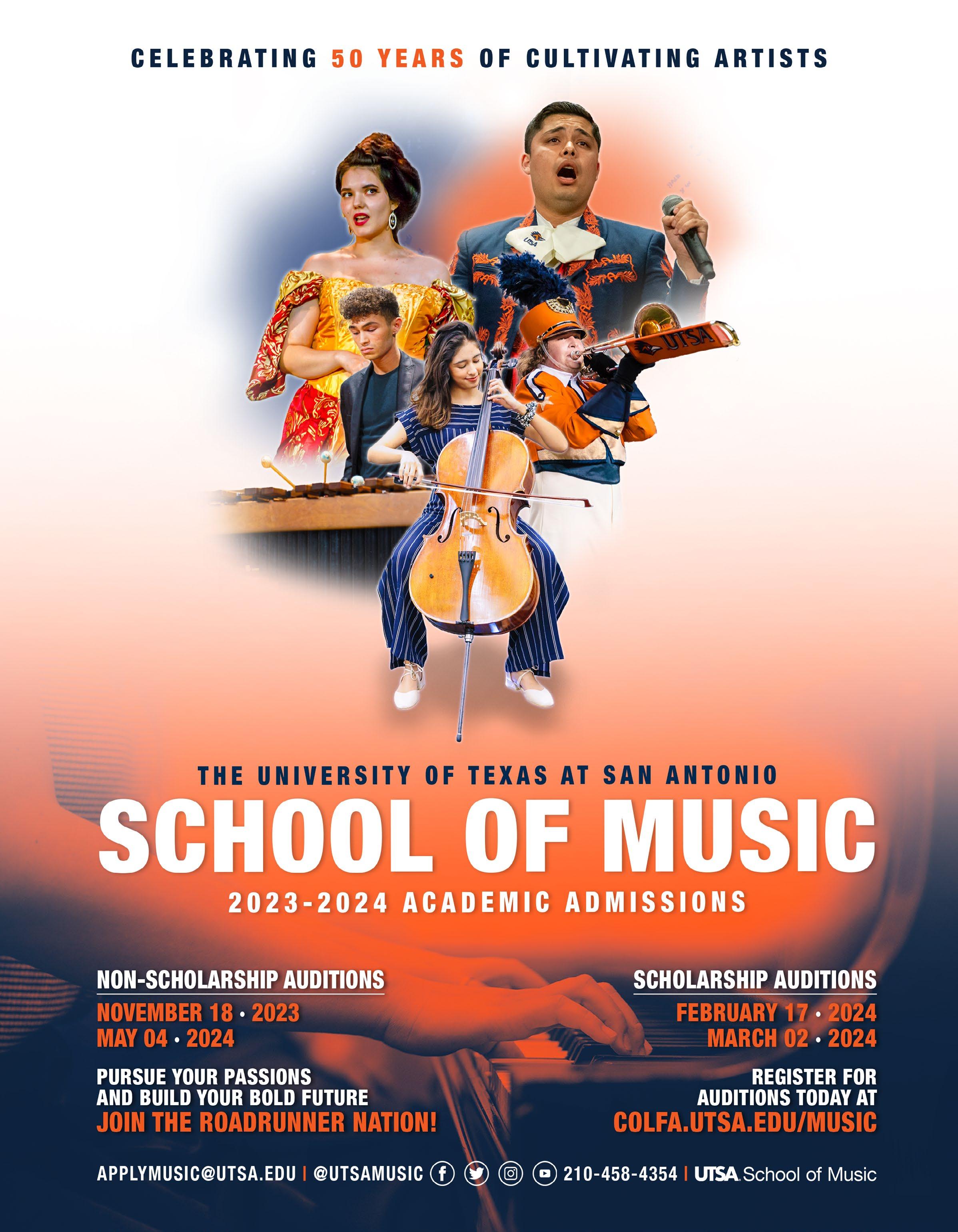
Page 39 |March 2024
MARCH 2024
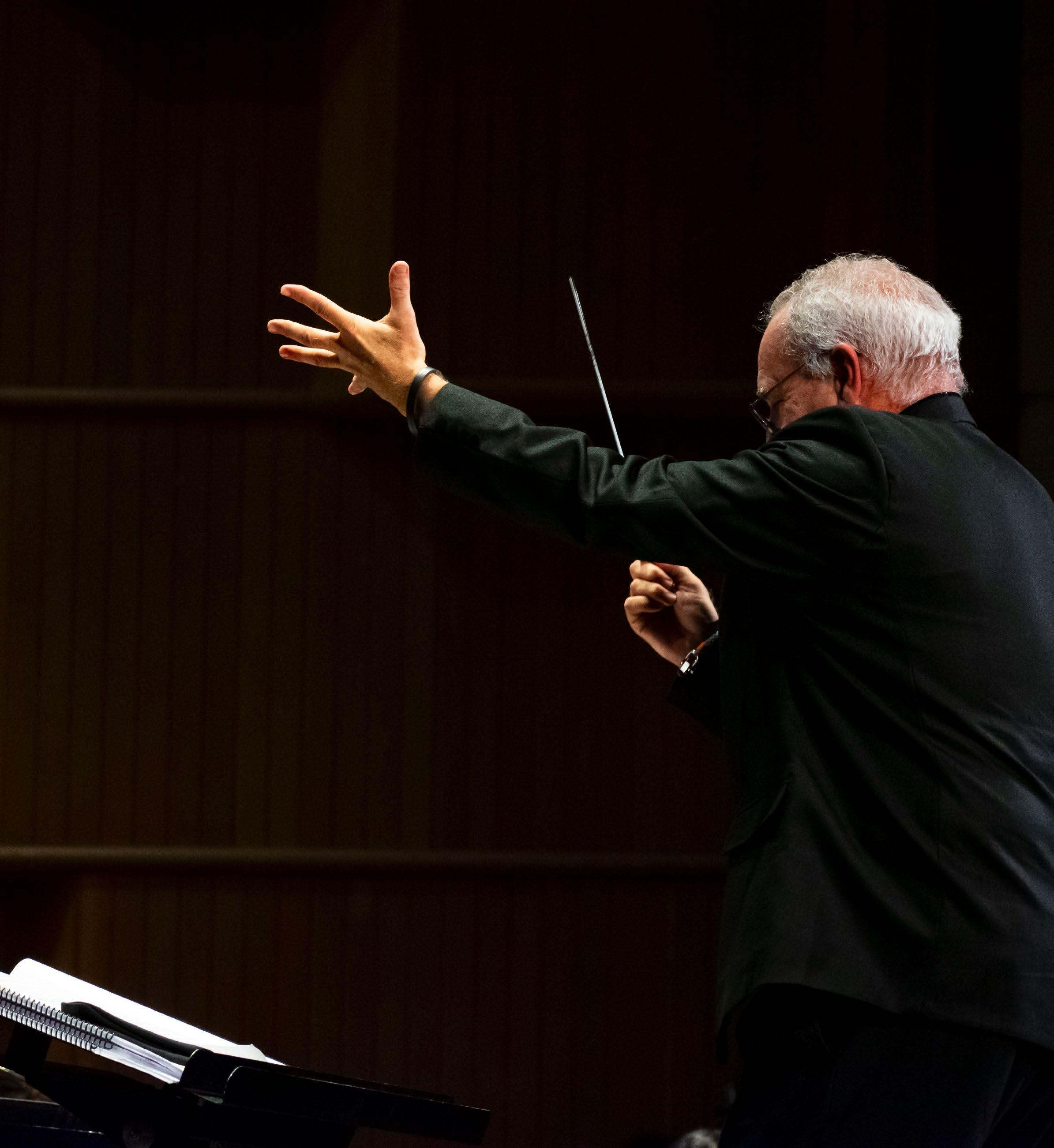
STAY UP TO DATE WITH THE LATEST INFORMATION ON THE UPCOMING
SEMESTER AT UTSA MUSIC MUSIC.UTSA.EDU
FOLLOW US! @UTSA







 Dr. Tracy Cowden
Roland K. Blumberg Endowed Professor in Music Director of the UTSA School of Music
Dr. Tracy Cowden
Roland K. Blumberg Endowed Professor in Music Director of the UTSA School of Music

























































































